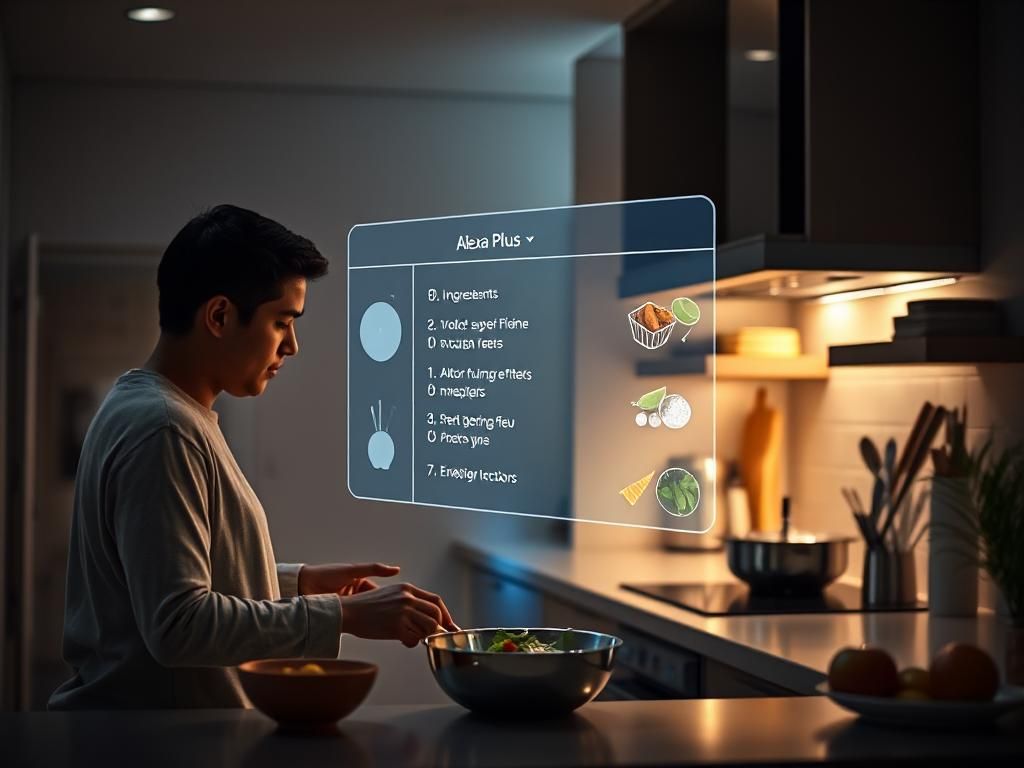In the evolving landscape of smart home technology, the arrival of Amazon’s generative AI-powered Alexa, dubbed “Alexa Plus,” marks a pivotal moment. After years of anticipation since its initial announcement in 2023, early access to this upgraded voice assistant reveals a profoundly transformed user experience. This is not merely an incremental update; it’s a redefinition of how we interact with our digital companions at home. While Alexa Plus promises a future of more fluid, intelligent, and human-like interactions, our initial deep dive uncovers both groundbreaking advancements and critical areas requiring refinement.
A PARADIGM SHIFT IN VOICE INTERACTION
The most striking change with Alexa Plus is its departure from the rigid, command-and-control structure of its predecessor. Powered by a sophisticated large language model (LLM), the new assistant excels in understanding natural, rambling speech patterns, complete with pauses, interjections, and mid-sentence corrections. No longer does a user face the frustrating “Sorry, I’m not sure about that” response when deviating from precise commands. Instead, Alexa Plus demonstrates an impressive ability to adapt, maintain context across multiple turns, and respond with a level of appropriateness previously unseen. This conversational fluidity is a monumental leap, making interactions feel less like talking to a machine and more like engaging with an attentive individual. The evolution of voice assistants means more than just understanding commands; it’s about dynamic interaction. For instance, imagine a future where the AI can even generate personalized audio responses or soundscapes tailored to your mood, a concept that hints at the capabilities of tools like a Free AI Audio Generator.
CULINARY COMPANIONSHIP: COOKING WITH CONTEXT
Putting Alexa Plus to the test in the kitchen immediately showcased its enhanced utility. Requesting a recipe, for instance, yielded not just a static display but an interactive, chatbot-style interface on smart displays like the Echo Show 8. While initially disorienting not to have the entire recipe visible, the true power emerged when the user realized they could dynamically query Alexa for specific information as needed. “Which spices do I need for the seasoning?” or “How do I make the sauce?” could be asked on the fly, with Alexa intelligently pulling the relevant details from the recipe. This on-demand, contextual assistance is a significant upgrade from the old Alexa, which often lost track or required manual scrolling. However, imperfections remain; during one cooking session, Alexa inaccurately claimed certain ingredient quantities were unavailable from the recipe it was actively reading, despite them being clearly listed. There were also instances where the assistant “lost” the recipe after a period of inactivity, requiring re-initiation, and on one occasion, it even appeared to “gaslight” the user by denying any prior conversation about the dish. These minor hiccups highlight the ongoing need for robust memory and contextual persistence in AI interactions.
NAVIGATING THE SMART HOME: BRIDGE BETWEEN OLD AND NEW
The integration of generative AI into smart home control presents a unique challenge: merging a flexible, interpretive intelligence with established, often rigid, routines and device commands. This friction became evident during a morning coffee routine. A simple request, “Alexa, make me a coffee,” which typically triggered a pre-set routine, was met with a surprising “I’m sorry, I can’t actually make coffee for you.” This response underscored Alexa Plus’s initial struggle to differentiate between a direct capability and a user-defined automation. Rephrasing the command to explicitly request the routine resolved the issue. More promising was the ability to directly command connected appliances by leveraging their inherent capabilities without pre-configuration, such as “Alexa, can you ask my coffee machine to make me a coffee grande?” This feature represents a crucial step towards true smart home intuitive control, where the assistant understands device functionalities and executes them without requiring users to memorize specific phrases or set up elaborate routines. While this area still shows signs of a transition phase, with some existing skills and APIs reportedly struggling to “jive” with the new system, the potential for vastly simplified smart home management is immense. This challenge of merging old and new functionalities isn’t unique to Amazon; rivals like Apple and Google are also grappling with similar integration complexities for their respective AI upgrades.
INFORMATION RETRIEVAL: THE ACCURACY IMPERATIVE
Alexa Plus’s conversational prowess extends beyond domestic tasks to general information retrieval, as demonstrated by a discussion about Wimbledon. The assistant provided relevant updates, player insights, and even launched the corresponding YouTube TV app. However, a significant concern arose during trip planning: the issue of AI hallucination. When asked about deals for Dollywood tickets, Alexa confidently presented an enticing, but utterly incorrect, price. While chatbots occasionally providing inaccurate information is a known limitation, a voice assistant confidently delivering false data within the home environment feels more jarring and potentially misleading than a text-based response that can be quickly cross-referenced with a simple web search. Amazon acknowledges that accurate, real-time information delivery is a “known limitation” for Alexa Plus in its early access phase. This highlights a critical challenge for generative AI in applications where trust and accuracy are paramount, especially when the AI has the potential to influence real-world decisions.
STREAMLINING ROUTINES AND PERSONALIZATION
One of the most exciting prospects for Alexa Plus users is the ability to create and modify smart home routines using natural voice commands. Historically, configuring complex routines in the Alexa app has been a cumbersome and error-prone process. The new voice-activated method allows users to simply describe their desired sequence of actions—e.g., “dim the living room lights to 60 percent, play relaxing music, and adjust the thermostat to 76 degrees every night at 6 PM”—and have Alexa Plus configure the details. While a single trigger per routine currently necessitates the creation of multiple routines for varied activation methods (e.g., scheduled vs. voice-triggered), the underlying capability is robust and highly appealing, particularly for multi-user households where setting up automations often falls to one tech-savvy individual. Furthermore, the updated user interface on Echo smart displays, particularly the Show 21 and 15, introduces redesigned widgets that are cleaner and more functional. The smart home widget offers enhanced interactivity and customization, and the calendar widget now supports full-screen day, week, and month layouts, although the inability to keep a full-screen widget fixed and the cramped UI on smaller displays remain minor drawbacks. The ability to control multiple disparate smart home devices with a single, complex verbal request (e.g., “turn off the hallway lights, set the thermostat upstairs to 78, and start the vacuum in the kitchen”) is also a significant convenience, demonstrating the AI’s improved comprehension of multi-faceted commands.
THE USER EXPERIENCE: OBSERVATIONS AND ROOM FOR GROWTH
Beyond specific task performance, several general observations emerged from the initial 24-hour immersion. The default voice, described as “way too peppy,” prompted an immediate switch to one of the eight alternative options, highlighting the importance of customizable personality. The welcome feature of continuous conversation, where the wake word isn’t required after the initial summoning, significantly enhances the flow of interaction, though the current 30-second timeout for engagement could be extended for more natural dialogue. The prominent chatbot-style text transcript, while demonstrating the AI’s internal processing, felt overwhelming on larger screens; a more subtle overlay or smaller window would improve screen utility. Crucially, the “Early Access” label is a key reminder that Alexa Plus is a work in progress. Several advanced features, such as agentic abilities to book services like plumbers or restaurants, are still absent from this early iteration. The ongoing challenge will be ensuring that as new capabilities are rolled out, they seamlessly integrate with the vast existing ecosystem of Alexa skills and connected devices, preventing further friction points.
THE HUMAN ELEMENT: PERSONALITY AND PERCEPTION
Perhaps the most profound observation relates to the psychological impact of a more “human” AI in the home. For users accustomed to a more utilitarian, less expressive voice assistant, the increased personality of Alexa Plus can be striking. The anecdote of a 14-year-old describing the new Alexa’s conversational style as “not nice” because “the way it talked back to you” underscores a fundamental shift in the human-machine relationship. This reaction wasn’t to rudeness, but to the mere presence of more distinct personality. As AI becomes more deeply embedded in our daily lives, particularly within the intimate space of our homes, the debate around whether machines should emulate human traits intensifies. The inherent paradox lies in the desire for a natural, intuitive interaction versus the potential unease of an artificial entity blurring the lines of sentience. This transformation raises important questions about trust, agency, and the very nature of companionship in an AI-infused future.
CONCLUSION: A PROMISING BUT IMPERFECT REVOLUTION
After an initial day with Alexa Plus, the verdict is cautiously optimistic. This generative AI-powered voice assistant represents a monumental leap forward for Amazon, offering a significantly more natural, intuitive, and helpful smart home experience. Its improved conversational abilities, contextual understanding in tasks like cooking, and the potential for voice-activated routine creation are genuinely promising. However, the early access phase reveals undeniable rough edges. Issues like occasional factual inaccuracies (hallucinations), friction points with established routines, and design choices regarding screen real estate indicate that Amazon still has significant work ahead. The integration of a powerful, adaptive AI into the complex reality of a smart home, where actions have tangible consequences, demands impeccable accuracy and reliability. While the transition to a more personalized, human-like AI may challenge user perceptions and require adaptation, the underlying promise of a truly intelligent, helpful home assistant remains compelling. Alexa Plus is not yet a flawless butler, but it is undeniably a more capable and engaging companion, hinting at a truly revolutionary future for smart home technology.

